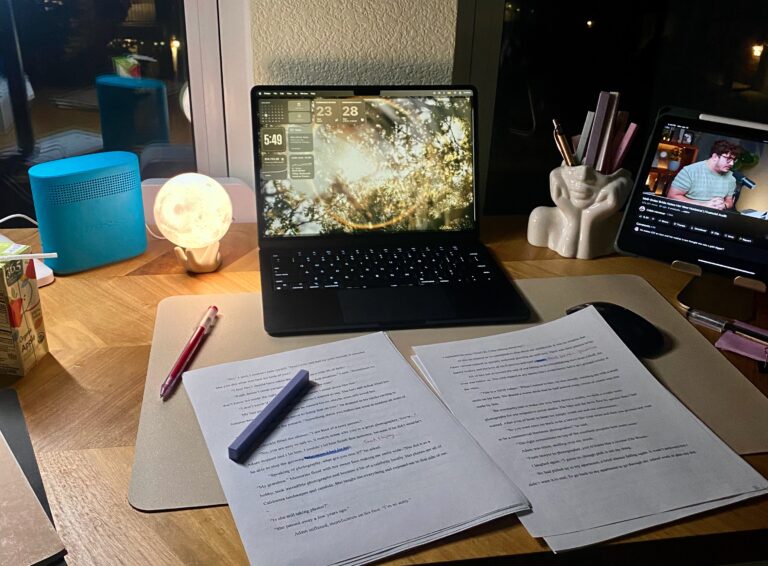By The Cheeky · November 2024

Introduction
Editing can be just as overwhelming—if not more so—than writing the first draft. There are countless ways to self-edit a novel, and when I first started, I was flooded with advice and steps. Editing is about much more than just correcting spelling and grammar; it’s about refining the heart of your story. Over time, I developed a streamlined, budget-friendly process that focuses on four main steps. Here’s my approach to editing without breaking the bank.
Why You Can Trust This Formula
As a new author on a budget, I needed an editing process that was both effective and affordable. Instead of relying on multiple professional editors for every draft, I focused on self-editing, ProwritingAid, and beta readers. This approach has helped me produce cleaner drafts with each novella. Here’s how I break it down into manageable steps:
Step 1: Edit the Big Picture
This step focuses on the overall structure and pacing. I use the Save the Cat model and a three-act structure to make sure each major beat is clear and that every scene adds to the story. For novellas, where word count is limited, every beat matters. I start by reading through the draft, making notes on scenes to expand or tighten, and tracking character growth to ensure they complete a satisfying arc.
Tips for Big-Picture Editing
- Create a new document for each draft to preserve the original.
- Summarize scenes in red if they need rewriting, then delete them once they’re revised.
Common Pitfalls
- If you’re new, beta readers can be invaluable for feedback on structure and character development.
- If possible, consider hiring a developmental editor for your first few projects to learn foundational techniques.
Step 2: Read Aloud for Flow and Clarity
Once the structure is solid, I load the document on my iPad and use the “Read Aloud” feature to hear the story. It’s an inexpensive way to catch typos, awkward sentences, and pacing issues. Listening lets me experience the story differently, helping to catch things I might miss when reading silently.

Tips for Reading Aloud
- Use a device with a markup tool to highlight areas needing work.
- For longer works, try to complete the read-through in sections so the story stays fresh.
Common Pitfalls
- With novellas, it’s possible to do a full read-through in a day by speeding up the reading pace. For longer books, set up convenient stopping points.
Step 3: Polish with ProwritingAid
ProwritingAid is my go-to tool for grammar and spelling checks. The paid version includes readability scores and other helpful reports. While there are other editing programs, I chose this one for its affordability and detailed feedback. It’s been a lifesaver for catching those hard-to-spot errors.
Tips for Using ProwritingAid
- Go chapter by chapter and make use of the reports on readability, sentence starts, and other elements.
Common Pitfalls
- Don’t blindly accept all suggestions; keep the character’s voice and the story’s tone in mind.
Step 4: Send to an Editor (or Beta Readers)

Hiring an editor can be expensive, but there are ways to make it work. Developmental editors, copy editors, and proofreaders each play different roles in polishing your book. I started by working with beta readers and a developmental editor for early projects, then switched to a more budget-friendly approach by hiring line editors and proofreaders on Fiverr. If an editor isn’t in your budget yet, swapping beta reads with other authors can be a great alternative.
Tips for Working with Editors
- If you can afford a line editor, they’re worth it, but you can start with beta readers or author trades.
- Request a sample from potential editors to make sure they understand your voice.
Common Pitfalls
- Don’t expect unpaid beta readers to catch everything a professional editor would.
- Remember that you get what you pay for—especially with editing.
Final Thoughts
After producing two novellas and now working on a third, this system has helped me manage costs while producing quality work. Combining beta readers with affordable editors from Fiverr has made editing achievable within my budget.

This process may not be for everyone, but it’s designed for authors who are just starting out and need a streamlined, cost-effective solution. I recommend developmental editors for the first few books to learn about structure and pacing, but beta readers can also be an invaluable resource, whether paid or through swaps with other authors.
Quick Summary of the Process
- Step 1: Edit for structure and beats.
- Step 2: Use the Read Aloud feature for flow and typos.
- Step 3: Use ProwritingAid for grammar and style checks.
- Step 4: Hire a line editor, or use beta readers if on a budget.
This guide focuses on producing a polished draft affordably, with options to invest more as your career grows.
Your Turn!
What editing process works best for you? Share your thoughts in the comments, and if you’re interested in beta reading for me, let me know!








